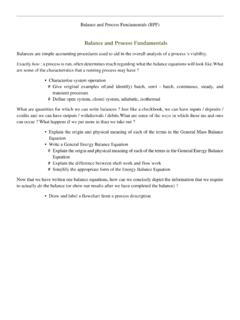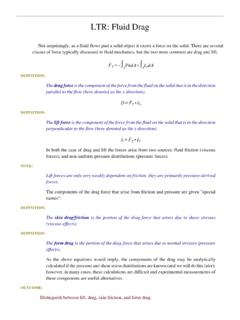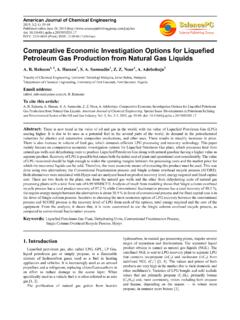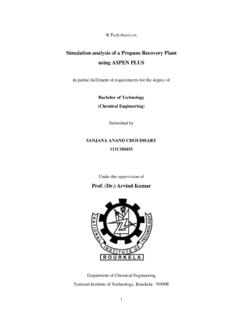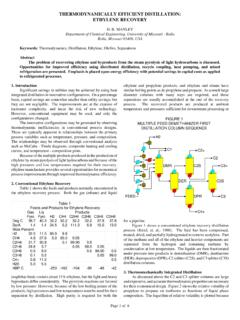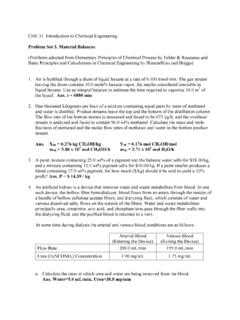Transcription of Performing Non - Reactive Mass and Energy Balances (NRB ...
1 Performing Non - Reactive mass and Energy Balances (NRB) Performing Non - Reactive mass and Energy BalancesNow that we know how to write the equations that will get us started for Balances , we need to worry about whenthey are do we know when to write these equations, or how many we need ? Perform single - unit mass Balances # Perform a degree - of - freedom analysis for a single - unit mass balance process# Do the calculations suggested in the degree - of - freedom analysisReal processes often include more than one process do we handle arbitrary numbers of units ?arbitrarily complex arrangements of those units ? Identify relevant sub - systems within a multi - unit process on which to perform a degree - of- freedom analysis(and subsequently do the required calculations) Perform mass Balances (degree - of - freedom plus calculations) for systems with recycle,bypass, and purge streamsEnergy Balances can be used as an additional equation in mass Balances .
2 Simplify and solve the General Energy balance for non - Reactive systems NRB: Perform a degree-of-freedom analysis for a single unit Degrees of Freedom AnalysisWhen attempting to solve a material balance problem, two questions that one may ask are: How many equations do I need? Where do they come from?DEFINITIONA Degrees of Freedom Analysis is used to answer these two questions. (For now we will onlyconsider non- Reactive systems.)Counting unknowns is simple! Just look at your (carefully drawn) flowchart. As you (should) remember fromalgebra, the number of equations necessary is equal to the number of are multiple places that the necessary equations might come from. **Material balance Equations = Number of independent species Energy balance Equations - These provide additional relationships, but will be covered laterin the course **Process Specifications or Constraints - These are provided in the problem statement.
3 Physical Properties/Laws - These include relations about the properties of the materials in theprocess. They may include relationships between volumetric flowrates and mass flowrates(density!), or equilibrium constraints (for example, dissolving sugar in water). **Physical Constraints - These include simple physical requirements, like the total mass ina stream is equal to the sum of the masses of components in the stream or (equivalently) thesum of mole (or mass ) fractions must be equal to 1. Stoichiometric relations - If a chemical reaction occurs, the stoichiometry of the reactiondescribes a relationship between the amounts of reactants and the amounts of the products.(For example A + 2B -> C would tell us that you must react two (somethings) of B for everyC that you make!)
4 OUTCOME:Perform a degree-of-freedom analysis for a single-unit mass balance process NRB: Do the calculations suggested in the degree-of-freedom analysis Material balance CalculationsAs suggested in the previous lesson, once the degrees of freedom analysis yields a value of zero, you have aroadmap for solving the material balance equations suggested by the Degrees of Freedom analysis (# of species = # of balanceequations; # of process specifications; # of physical constraints) MUST be the equations usedto solve the material balance !General Procedure for (single unit) Material BalancesSTEP 1 Choose a basis of calculation from among the given 2 Choose one of the given stream amounts (batch) or flowrates (continuous or semi-batch) OR(if no stream amounts or flowrates are given) choose something convenient (like 100 mol(/s)or 100 g(/s)).
5 IMPORTANTIts called conservation of mass not VOLUME, do NOT choose a volume as your basis!STEP 3 Draw the flowchart. (Follow the procedure previously outlined.)IMPORTANTR emember, to fully specify a stream, you must know BOTH the total amount of the flow withinthe stream and the composition of the stream (label what you DON'T know with variables).(Alternatively, you can know the flow of each component separately.)STEP 4Do the degrees of freedom analysis. (Follow the procedure previously outlined.) Can you matchthe number of unknowns with the number of equations? ( , is the DofF = 0?)IMPORTANTR emember, if they DO NOT match, you may have a problem! If there are too few equations,you CAN'T solve it. If there are too many, you MAY solve the problem, but then you mustCHECK THE ANSWER against your additional equations (the problem may be overspecified).
6 STEP 5If DofF is zero then simply do the algebra for each of the equations suggested by the DofF!OUTCOME:Do the calculations suggested in the degree-of-freedom analysis NRB: Single-Unit Example 1 Single Unit Material balance ExampleOnce you have completed the Degrees of Freedom analysis, you literally have a roadmap for solving the in any simple algebraic problem (OK, it is a system of algebraic equations so maybe its not THAT simple!)you have matched the number of unknowns with the number of equations. You now simply use those equationsto find those unknowns!OUTCOME:Do the calculations suggested in the degree-of-freedom analysisTEST YOURSELFLet's actually solve the example that we have already looked many Unknowns are there?How many different Species(material Balances ) are there?How many Process Specifications are we given?
7 How many Physical Constraints are there?The total number of Degrees of Freedom isLet's start with material a differential balance equation (since it is a continuous process), let's write down our material we can solve them, let's do so , let's write down our process we can solve them, do it , let's write down our physical we can solve them, do it may need to solve several (all) of these simultaneously or there may be a "preferred" orderin which we should solve them!TEST YOURSELFTry one NRB: Single-Unit Example 2 Another Single Unit Material balance ExampleOne thousand kilograms per hour of a mixture containing equal parts by mass of methanoland water is distilled. Product streams leave the top and bottom of the distillation flow rate of the bottom stream is measured and found to be 673 kg/h, and the overheadstream is analyzed and found to contain wt% the flow and composition of all of the first step is to draw the flowchart.
8 Let's start many Unknowns are there?How many different Species(material Balances ) are there?How many Process Specifications are we given?How many Physical Constraints are there?The total number of Degrees of Freedom is NRB: Identify relevant sub-systems within a multi-unit process Multi-Unit balance CalculationsSo far we have only looked at single-unit processes. Here we might consider the system to be solely the processunit itself (we had no other choice).DEFINITIONA system is the region of a process on which we are currently Performing a balance . You willtypically think of a box surrounding this "system" and will perform the balance on the most real process, we have more than one process unit. In these cases, it will often be convenient (or evennecessary) to define our system as something other than one single process unit.
9 Look at the following diagramas an example:Once we have chosen a sub-system, however, the problem becomes identical to a single-unit process (whereour sub-system plays the role of the single unit!).(New?) Method for solving multi-process units: Choose a Basis Draw Flowchart Choose a Sub-system! Degrees of Freedom Do AlgebraIMPORTANTA multi-process system requires: that you be clever in choosing your system, that you solveequations in the "right" order, that you remember how to solve a system of algebraic :Identify relevant sub-systems within a multi-unit process on which to perform a degree-of-freedom analysis (and subsequently do the required calculations)TEST YOURSELFLet's try NRB: Multi-unit Example Multi-Unit Process ExampleFrom the following process description draw a flowchart that concisely summarizes each stage of the process(properly labeling all streams and species within those streams)A mixture of two components, A and B, are fed at 100 kg/hr to a process unit (Unit 1) inequal parts by mass .
10 One stream, which contains 90 mass % A exits this unit at a rate of 40kg/hr. A second stream leaves Unit 1 and is mixed with a 30 kg/hr stream which is 70 mass % B. This combined stream serves as the inlet for Unit 2. One of the two outlets (flowingat 30 kg/hr) from Unit 2 is analyzed and found to contain 60 mass % you are finished, let's try to analyze this system! NRB: Multi-unit Example (cont.) Multi-Unit Process Example (cont.)If you had correctly drawn the flowchart, you would have obtained the image below. If not, why not try again?The next step in doing the material balance is to choose a subsystem to analyze. Let's trythat together define your subsystem simply click in the area below to signify the vertices of your subsystem "box" (aclosed shape containing all the process units you would like to include in your subsystem) and then click"Analyze the Subsytem".
